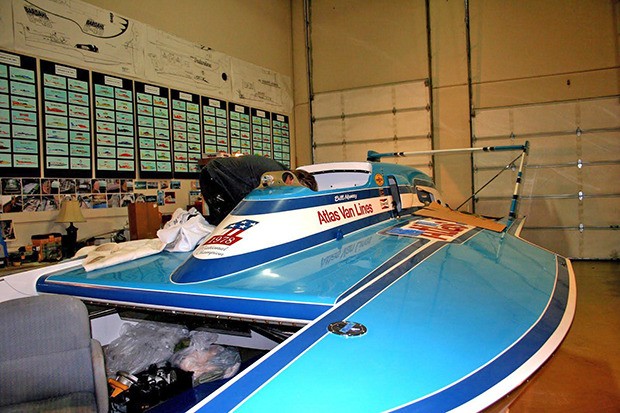By Kierra Elfalan
For Auburn Reporter
Hydroplane enthusiasts got the chance to see one of the sport’s most storied boats for free during the Hydroplane & Raceboat Museum’s Hydro Fever open house last weekend.
The boat, known to the hydroplane community as the “Blue Blaster,” a nickname for sponsor Atlas Van Lines, is close to being restored after more than four years of work. As the pride and joy of the Kent museum, it is set to run at Seafair this summer.
But there have been mixed emotions about seeing the boat on the water again after Bill Muncey’s 1981 accident in Acapulco, Mexico. The legendary driver was killed during his final competition at a world championship race when he lost control of his boat.
“It was such a traumatic event when (Muncey) was killed, and it’s such a touchy, emotional subject,” said Don Mock, a volunteer who has been with the museum since its beginning in 1984 and has been working on a crew to restore the boat.
“A lot of people felt the boat should never run again, (that) it should be sort of a tribute or a shrine (and that) it should never touch the water,” Mock said.
Muncey left behind a family, including son Will Muncey, who was at the event promoting a book he wrote about his father’s life. As a Muncey he too was a hydroplane driver. Four generations of his family were involved in hydroplane racing, whether as drivers or as crew members.
“If you go back to like the ’50s and ’60s, especially the ’50s, we didn’t have the Seahawks,” Muncey said. “In the ’50s, we didn’t even have any kind of major league sports. This was the only thing we had that was truly, legitimately, major league.”
Many members of the hydroplane community who feel this way about the sport were also at the event, among them volunteers who have worked at the museum for years.
“We would go down to the lake every Monday through Friday, pack a picnic lunch, a blanket and go out and sit on the beach and watch (the boats) go round and round the lake,” said volunteer Carolyn Graham, who grew up watching the sport.
But every time the old days of racing were brought up, Muncey’s name and memories of his boat seemed to find their way into the conversation. Graham described him as the name in Seattle, a racer everyone thought was wonderful.
“A lot of people have ties to this racing activity, so I think that (will) be a very good thing to see that boat on the water,” Muncey said.


